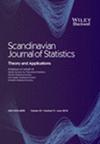基于Wasserstein - Procrustes度量的基于协方差的功能数据软聚类
IF 1
4区 数学
Q3 STATISTICS & PROBABILITY
引用次数: 0
摘要
摘要根据函数数据的协方差结构,研究了函数数据的聚类问题。我们提出了一种基于Wasserstein - Procrustes距离的软聚类方法,其中聚类之间的可变性由与划分矩阵的熵成比例的项来惩罚。这样,每个协方差算子可以部分地划分为多个组。这种软分类允许集群重叠,并且在所有或某些集群之间的分离没有很好定义的情况下自然出现。我们还讨论了如何估计组的数量和测试是否存在任何簇结构。用仿真数据和实际数据对该算法进行了说明。在补充资料中有R的实现。这篇文章受版权保护。版权所有。本文章由计算机程序翻译,如有差异,请以英文原文为准。
Covariance‐based soft clustering of functional data based on the Wasserstein‐Procrustes metric
Abstract We consider the problem of clustering functional data according to their covariance structure. We contribute a soft clustering methodology based on the Wasserstein‐Procrustes distance, where the in‐between cluster variability is penalised by a term proportional to the entropy of the partition matrix. In this way, each covariance operator can be partially classified into more than one group. Such soft classification allows for clusters to overlap, and arises naturally in situations where the separation between all or some of the clusters is not well‐defined. We also discuss how to estimate the number of groups and to test for the presence of any cluster structure. The algorithm is illustrated using simulated and real data. An R implementation is available in the Supplementary materials. This article is protected by copyright. All rights reserved.
求助全文
通过发布文献求助,成功后即可免费获取论文全文。
去求助
来源期刊

Scandinavian Journal of Statistics
数学-统计学与概率论
CiteScore
1.80
自引率
0.00%
发文量
61
审稿时长
6-12 weeks
期刊介绍:
The Scandinavian Journal of Statistics is internationally recognised as one of the leading statistical journals in the world. It was founded in 1974 by four Scandinavian statistical societies. Today more than eighty per cent of the manuscripts are submitted from outside Scandinavia.
It is an international journal devoted to reporting significant and innovative original contributions to statistical methodology, both theory and applications.
The journal specializes in statistical modelling showing particular appreciation of the underlying substantive research problems.
The emergence of specialized methods for analysing longitudinal and spatial data is just one example of an area of important methodological development in which the Scandinavian Journal of Statistics has a particular niche.
 求助内容:
求助内容: 应助结果提醒方式:
应助结果提醒方式:


